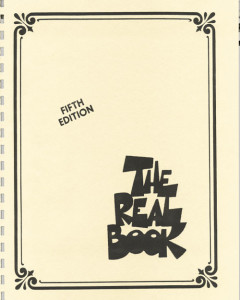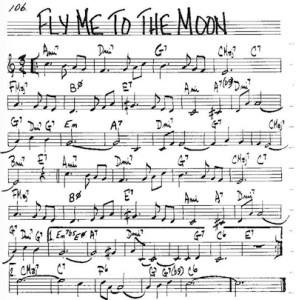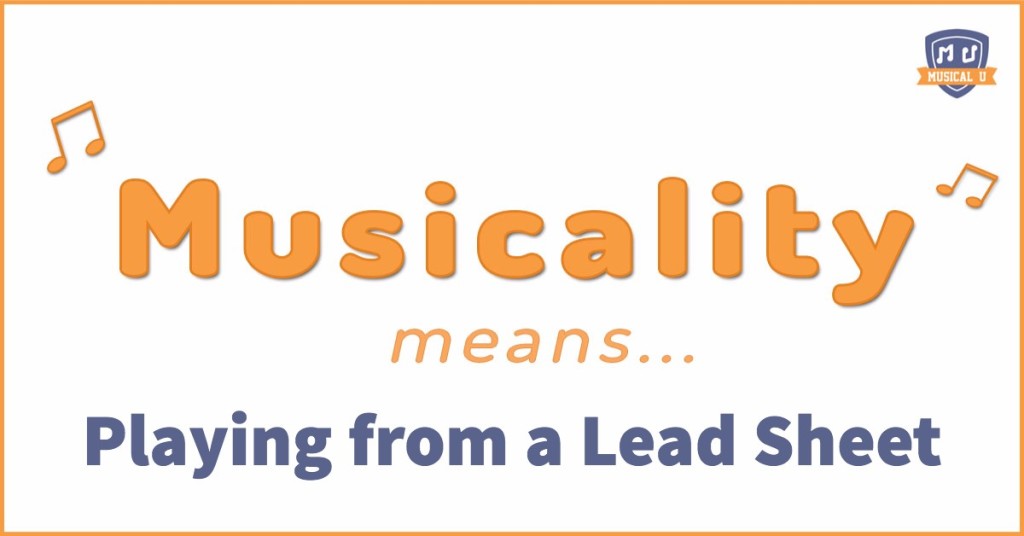In this series of posts we explore musicality: what it means to be “musical”.
Sometimes you’ll see musicians take out a big book containing literally hundreds of songs – or pass around a single sheet containing a whole song. How is that possible when traditional sheet music can span several pages just for one piece?
The answer is they’re using lead sheets, and being able to play a song just from a lead sheet or “fake book” is an important skill of musicality.
What is a “lead sheet”

Lead sheets are often collected into a thick volume called a “fake book”, so-called because it allows you to “fake your way” through a piece you haven’t learned before.
If you’re used to reading from detailed score notation this can seem impressive, even mysterious. When you’ve learned the skills required however, it’s easy to glance at a lead sheet and then play the melody, chords or bassline on your instrument straight away.
Why playing from a lead sheet matters
Fifty years ago lead sheets were only really used in jazz music. Because jazz musicians would often “sit in” with a group they’d never played with before, and jazz was so heavily centred around playing “standards”, a jazz musician was expected to either know hundreds of these tunes from memory – or be able to fake their way through them. Over the years it became normal for jazzers to carry a fat collection of photocopied lead sheets, so that if they were sitting in with a group and called on to play a standard they didn’t know, they could flick through their stack of sheets, find the one required, and then join in as if they’d been playing it for years.

Example of a jazz lead sheet
These days you can find lead sheets for all genres, including pop and rock – and even classical! It means you can buy just a single cheap volume of sheet music and have hundreds of tunes at your fingertips. Of course now you can even get the equivalent digital versions to display on a tablet, or glance at on your phone in the middle of a gig.
Being able to play from a lead sheet is important in two major ways. The first is the obvious one: it gives you instant access to an enormous range of songs without needing to carefully learn them note-by-note for hours before you ever perform them. This gives you much greater versatility as a performer and collaborator. Not to mention it’s just fun for your own enjoyment of exploring new music quickly.
The second major benefit of learning to play from lead sheets is that it is a perfect vehicle for developing your musicality in various ways.
Learning a piece from full score notation requires careful sight-reading and an admirable attention to detail. Playing from a lead sheet on the other hand requires inner musicianship: an ability to look “beyond the dots” and understand the underlying music.
It relies on you to turn a simple melody into an expressive rendition, or take a collection of chord symbols and bring forth a full and expressive musical arrangement. If you’re a singer it pushes your sight-reading skills to the limit, and if you’re a bass or percussion player it truly challenges your skill in creating a suitable groove from scratch for a variety of situations.
How you learn to play from a lead sheet
There are two parts to learning to play from a lead sheet. Many musicians make the mistake of only focusing on the first, but you’ll get far better results if you do both together.
The first part is simply to practice playing from lead sheets. Get yourself a fake book. In jazz the “Real Books” are king. In other genres search for “fake books”, books which offer “lyrics, lead and chords” or which boast hundreds of songs in a single volume.
Then, set yourself a daily task of playing from the lead sheet. If you play a lead instrument such as lead guitar, trumpet, or sax, you’ll focus on playing the melody. If you play a chordal instrument such as piano or rhythm guitar, play through the chord symbols. If you play bass, naturally you’ll create a bassline based on the chords. And if you sing… well, you know what to do!
Begin by trying to sight-read the song straight off. Then, find a recording. You may or may not know the song already, but either way listen to a recording and then try your performance again, imitating the style you just heard. If possible, find a different recording and try adapting your performance to reflect how that one was played. A big part of playing from a lead sheet is creating the musical style from scratch in the way you interpret the skeleton score.
The important part of practicing lead sheets is to move on quickly. You aren’t aiming to master each song, but rather to get better at quickly reaching a “good enough” version of a song you’re seeing for the first time. So tomorrow, try a new one. Do feel free to return to previous ones in due course, it can be fun to build up your repertoire in this way, but the key thing is to keep practicing new lead sheets.
The second part of learning to play from lead sheets is what will accelerate your progress. That is to practice the core listening skills which enable you to go from the barebones notation of a lead sheet into a full and expressive musical performance.
Again, the details will depend on your instrument, but here are a few examples to give you the idea:
- Developing your relative pitch and improvisation skills to let you interpret the melody and play a solo.
- Learning about chord progressions so you can glance at a lead sheet and understand the chord symbols.
- As a singer, learning solfa so that you can easily sight-read from the melody score of a lead sheet.
- Doing rhythm ear training to understand how to interpret rhythm notation and create a swinging groove.
By working on each of the component skills that go into playing from a lead sheet, you can rapidly develop your musical instinct so that playing from a lead sheet seems easy and natural.

How Musical U can help you play from a lead sheet
At Musical U we focus on teaching the “inner skills” of music, meaning we help you understand the notes you hear in music, how it all fits together, and how to express yourself through your instrument.
When it comes to lead sheets, that means we help with part two described above: teaching you the fundamental skills you need to look at a lead sheet you’ve never seen before and say “Sure, I can play that.”
By using the training modules inside Musical U you can learn to look at notes on a page and audiate the music, meaning you hear it in your head. You also learn to express the music in your head on your instrument. This may seem inefficient compared with simply sight-reading from full music notation, but in fact it provides you with musical freedom. It’s the perfect match for lead sheets: instead of being chained to note-by-note robotic playing, you take a simplified score like a lead sheet, interpret it in your own way using your musical imagination, and then know how to play your part on your instrument.
Musical U offers training for playing melodies, learning chord progressions, sight-singing with solfa, getting a great sense of rhythm and more.
With the help of Musical U training modules you can easily develop the kind of all-round musicianship required to confidently play well from a lead sheet.
Musicality means playing from a lead sheet
Being able to play from a lead sheet lets you easily play a song you’ve never heard before, or confidently join a group for a performance even if they’re playing tunes you don’t know.
That can be really handy, but it’s not actually the biggest benefit of learning to play from lead sheets.
Playing from a lead sheet truly matters because it’s the perfect test-bed for your musicality: Learning to play well from a lead sheet offers you the ideal opportunity to develop the “inner skills of music” you need to be a confident, capable, expressive musician.
You’ll learn to break free from note-by-note score reading and bring the music in your head out into the world.
You’ll learn to be versatile across genres and styles of music.
You’ll learn to be fearless when confronted with unfamiliar repertoire because you know you can spin your own great renditions, practically out of nowhere.
Whether or not you ever literally get handed a lead sheet and need to perform from it, learning to play from lead sheets is a superb way to develop your musicality. So grab yourself a “fake book” and get started!







